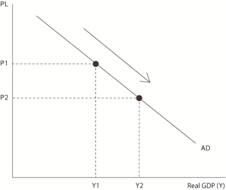
To explain:
The three reasons for the aggregate demand curve to slope downward and the factors affecting the shift.
Explanation of Solution
The downward sloping of aggregate demand is shown in the figure below:

Figure (A)
The three reasons for the aggregate demand curve to slope downward are:
Wealth effect:
The aggregate demand curve is sketched on the basis that a constant supply of money is maintained by the government. As the
Interest rate effect:
As prices rise, households and businesses need more money to manage their operations. But the money supply is fixed. The increase in demand for a fixed money supply leads to the rise in price of money and interest rate. As interest rate rise, interest sensitive expenditure will decrease. The other reason for the inverse relationship between the price level and the demand for real GDP is therefore the interest rate effect.
Net exports effect:
As the rate of domestic prices rises, international made products become comparatively cheaper in order to increase demand for imports. Moreover, the increase in the domestic price level also implies that domestic made products are comparatively more costly to overseas consumers, thereby reducing demand for exports. Net exports reduce as imports rise. Since net exports are an element of real GDP, there is a decline in real GDP demand as net exports fall.
The three factors affecting the shift in the aggregate demand curve are:
Exchange rates:
When the exchange rate of a country rises, net exports reduce and aggregate expenditure decreases at all rates. This implies the decrease in the AD curve.
Distribution of income:
This relates directly to salaries and revenues. When the real wages of the worker rise, individual will have more money on their hands since they have increased their overall income. When this occurs, they prioritize consumption, leading to higher consumption costs.Foreign income:
This refers to U.S. economic output to worldwide revenue from its trading partners. U.S. exports will rise when foreign revenue increases, causing aggregate demand to rise.
Aggregate demand:
Aggregate demand (AD) is the total quantity of products and services that customers are prepared to buy in a specified economy over a period of time. Occasionally aggregate demand moves in a manner that changes its
Want to see more full solutions like this?
Chapter 26 Solutions
Principles of Economics (Second Edition)
 Essentials of Economics (MindTap Course List)EconomicsISBN:9781337091992Author:N. Gregory MankiwPublisher:Cengage Learning
Essentials of Economics (MindTap Course List)EconomicsISBN:9781337091992Author:N. Gregory MankiwPublisher:Cengage Learning Brief Principles of Macroeconomics (MindTap Cours...EconomicsISBN:9781337091985Author:N. Gregory MankiwPublisher:Cengage Learning
Brief Principles of Macroeconomics (MindTap Cours...EconomicsISBN:9781337091985Author:N. Gregory MankiwPublisher:Cengage Learning
 Economics (MindTap Course List)EconomicsISBN:9781337617383Author:Roger A. ArnoldPublisher:Cengage Learning
Economics (MindTap Course List)EconomicsISBN:9781337617383Author:Roger A. ArnoldPublisher:Cengage Learning






